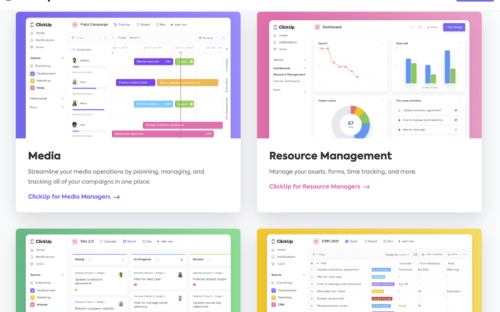Article's Content
What do you do when you don’t understand a word or phrase?
With over 9 billion searches happening daily, you probably Google it.
In fact, people use search engines so much that “Googling” and “Google it” are now used to describe the act of searching for information on the internet.
Considering that a significant percentage of people use search engines as a dictionary, it’s a no-brainer for you to create glossary pages — especially if you use a lot of industry-specific terms or jargon.
And that’s exactly what the team at Databricks did. We like to call it the keyword glossary strategy.
This keyword glossary strategy has played a significant role in helping Databricks achieve:
- A $38 billion valuation.
- Over 6,000 customers.
- More than half of their website’s value.
This case study will take a deeper look into how Databricks built out its glossary pages to attract a lot of traffic and prospects in the cloud data niche. And, more importantly, how you can do the same too.
Building an SEO Moat Through Glossary Pages
The glossary keyword strategy is the process of creating glossary pages — landing pages that define specific terms around your niche or industry — to serve prospects looking for information.
Unlike B2B SaaS brands in popular spaces like project management, marketing, or sales, the Databricks team is in a rather niche market: AI and Big Data analytics. As such, they don’t have the luxury of having keyword terms with thousands of monthly searches. What companies like Databricks do have going for them are the many industry-specific terms with which few people are familiar.
For instance, imagine you’re reading a guide on data storage systems and you come across the term ACID transactions. Unfortunately, you don’t know what it means, and since it’s an industry-specific term, your dictionary is of no help.
Where do you turn?
You type the words into Google, and the first result is this glossary page from Databricks that perfectly defines the term.
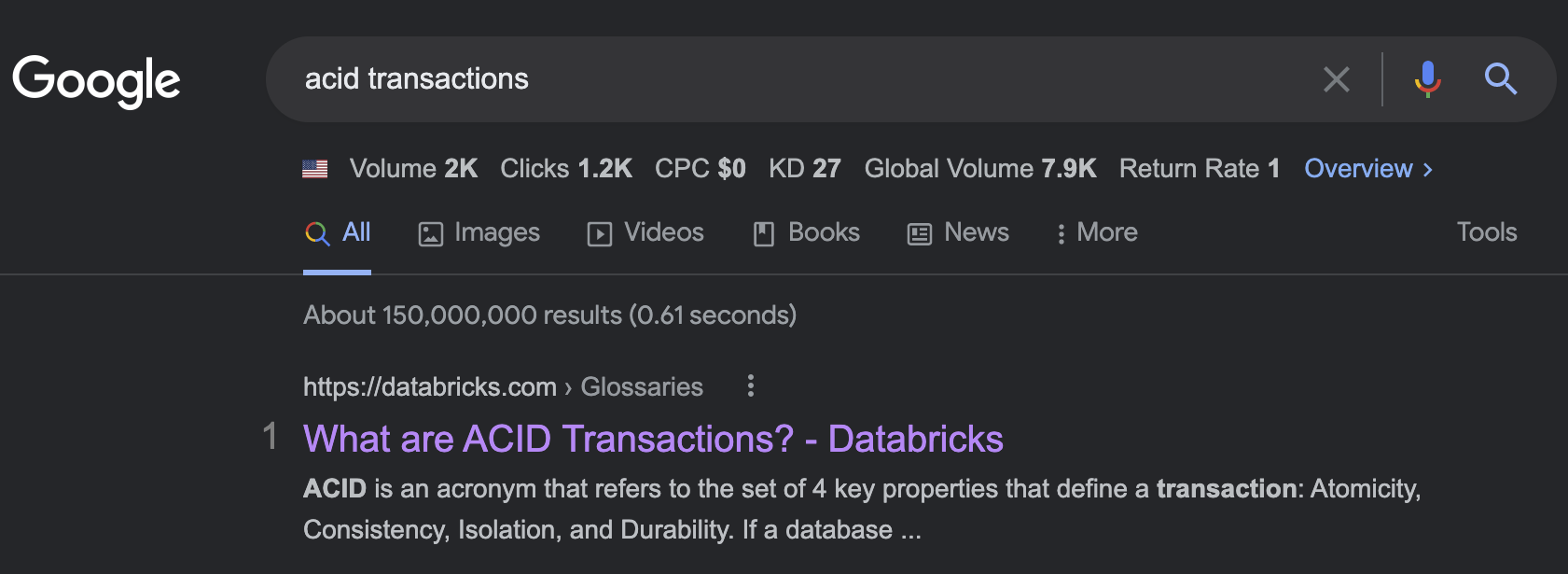
The glossary keyword strategy helps Databricks rank for over 14,000 industry-specific terms.
Here’s a look at the scorecard for Databricks’ glossary page.
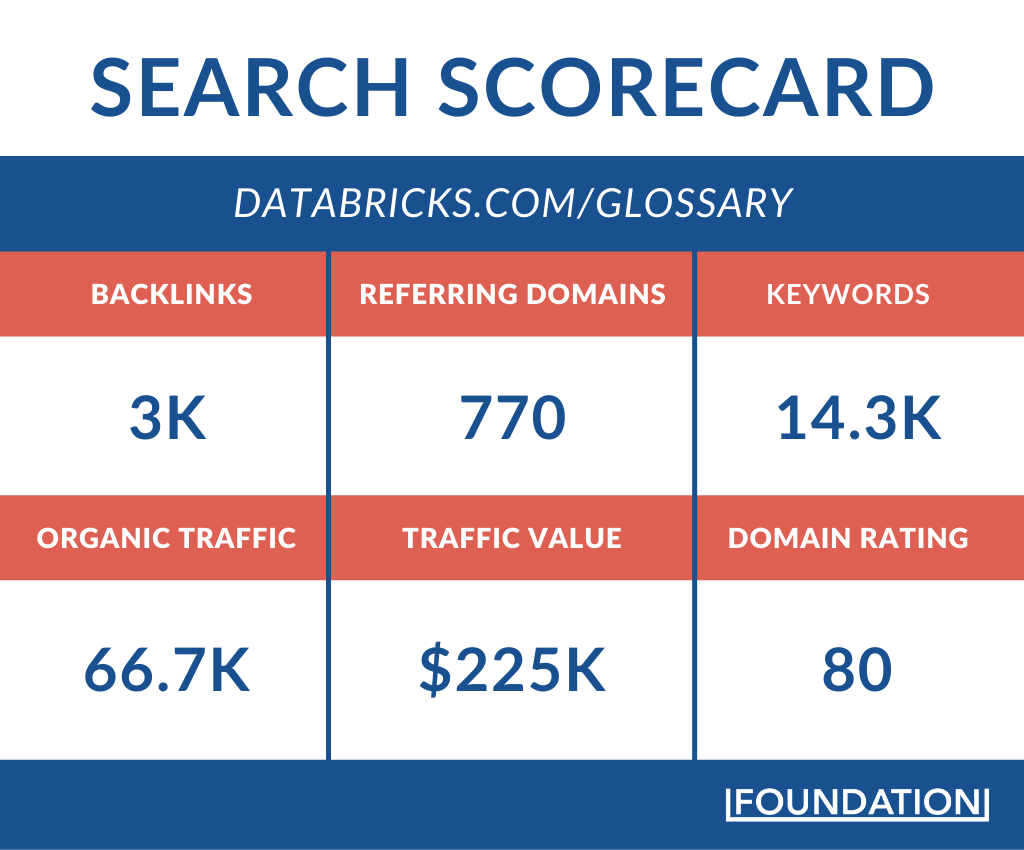
Compared to the numbers their competitors pull, you can tell that Databricks is leading the pack. For instance, Databricks’ glossary — not their whole website — attracts more organic traffic than the entire website of competitors like Qubole and Dremio.

That’s bonkers when you think about it.
Let’s now consider why Databricks create glossary pages and why you should do the same.
Educate & Convert Prospects
When you pick up a dictionary, you want to learn the meaning of a new word. Similarly, when people look for industry-specific terms, it’s because they want to learn more about the topic.
The Databricks team understands the informational intent behind the searches people make and so they’re able to provide valuable content that matches that intent.
Since it’s unlikely people searching for these terms want to satisfy a transactional intent, Databricks does well not to overly promote their products. Instead, they provide high-level content that satisfies the curiosity of prospects.
For instance, Databricks ranks for the term “ETL,” which has over $122,400 in traffic value and generates 8,600 in organic traffic.

The page goes into detail to answer the reader’s questions about ETL. Then, as readers scroll farther down the page, they’re met with a simple CTA that encourages them to create a free account with Databricks.
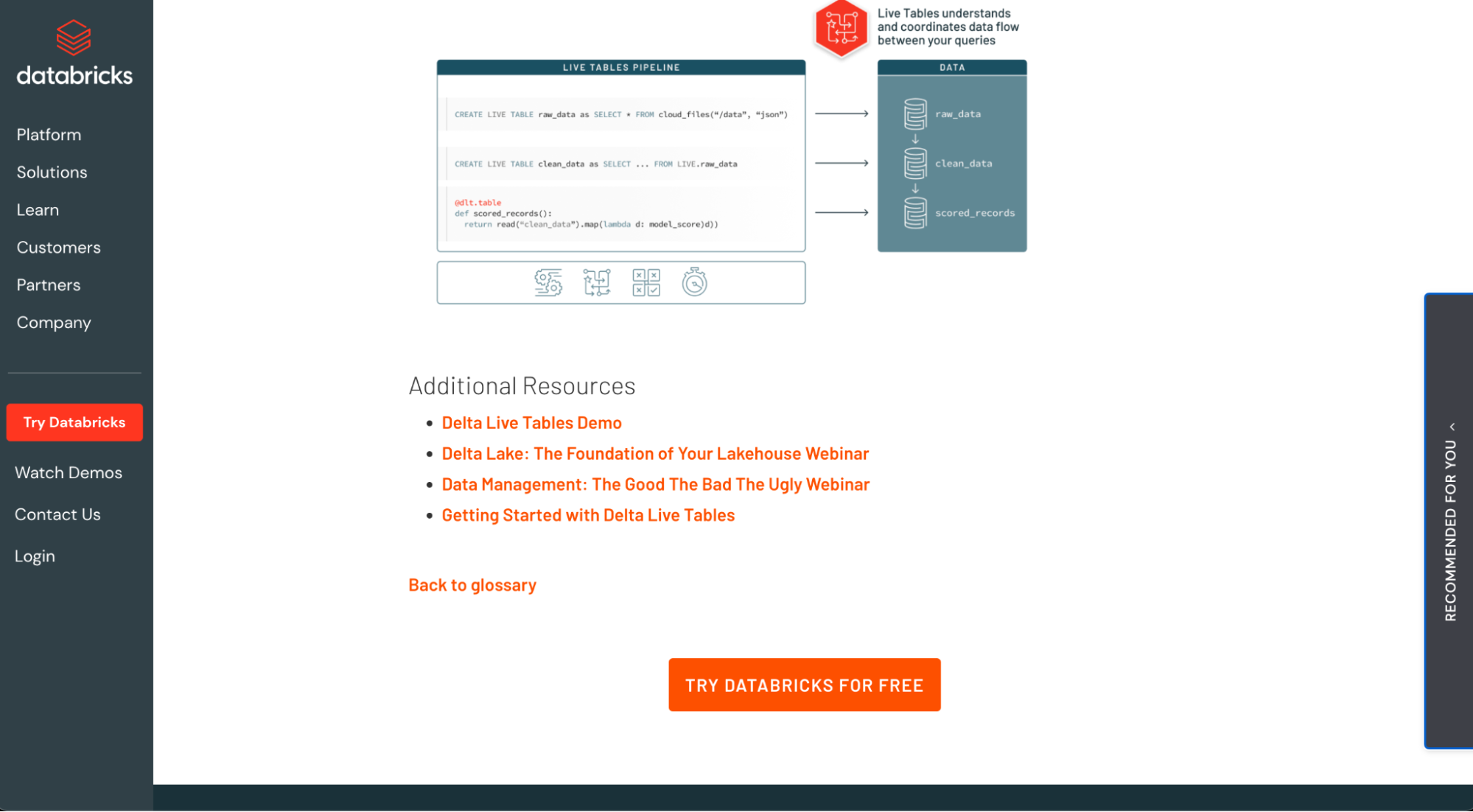
Even though the content is for prospects at the top of the sales funnel, including the CTA at the bottom of the page serves as a non-intrusive chance for conversion.
To run some numbers, let’s assume this page has a conversion rate of 3%. With 8,600 in monthly traffic, 258 people sign up for Databricks every month.
That’s not a bad return from a single piece of content.
Better Results on the SERP
Databricks’ glossary pages rank for over 14,000 keywords, which would have cost $225,000 in Google Adwords spend if they chose a paid approach instead. Not only do they get to save money, but these glossary pages have allowed Databricks to enjoy a considerable measure of success on the search engine results page.
Ever since Databricks started creating glossary pages in April 2018, they’ve been able to build an impressive SEO moat that helps them stand out on search engines and attract prospects they can guide through the sales funnel.
Improved Authority and Thought Leadership
Just as consistently creating blog posts or content around a specific topic builds your authority, so too does creating glossary pages. As people search for and find the over 14,000 keywords Databricks ranks for, their authority grows — and so too does their position as thought leaders in the AI and Big Data analytics niche.
In addition, creating these valuable glossary pages helps contribute to Databricks’ expertise, authority, and trustworthiness factor (EAT) in the eyes of Google. To further improve their authority, Databricks could form and popularize new terms for other members of their industry to adopt.
You’ve seen what glossary pages can do for your B2B SaaS brand. But how can you create pages that work?
Let’s borrow a page from Databricks’ playbook.
How to Structure Your Glossary Page
While we’ve likened glossary pages to dictionaries in this case study, your glossary pages need to provide more than just a term and its meaning — the way dictionaries do. Your glossary page should provide readers with the information they need to understand the term clearly. And even so much so that they can now explain what it means in basic terms to others. People are already having a hard time understanding your industry speak, so now’s not the right time to get even more technical or corporate with them.
Here’s how Databricks built out its glossary pages and some best practices to follow.
Choose the Right Terms
The terms you choose to target serve as the foundation on which your glossary page stands. Choosing the right keywords will have you sitting pretty on the SERP.
So how do you choose?
Start with good ol’ keyword research. Plug the terms that describe your business into your favorite SEO tools and look for associated phrases. You can filter your search to show results that include words like:
- ABC definition
- What is ABC
- Definition of ABC
- Define ABC
- What does ABC mean
And so on.
You can also ask your customers and internal teams directly, or search for terms and phrases common in your industry.
For Databricks, these terms include:
- ETL
- Data lakehouse
- Lambda architecture
- ACID properties
- Bayesian neural networks
Once you’ve uncovered the right terms to target, the next step is choosing how to structure each glossary page.
Structuring Individual Glossary Pages
When you land on the databricks.com/glossary URL, the first thing you’ll notice is how well organized the glossary terms are.
Without too much effort, visitors can quickly look for terms using the search bar or by clicking any of the A-Z buttons to sort the terms into different sections.
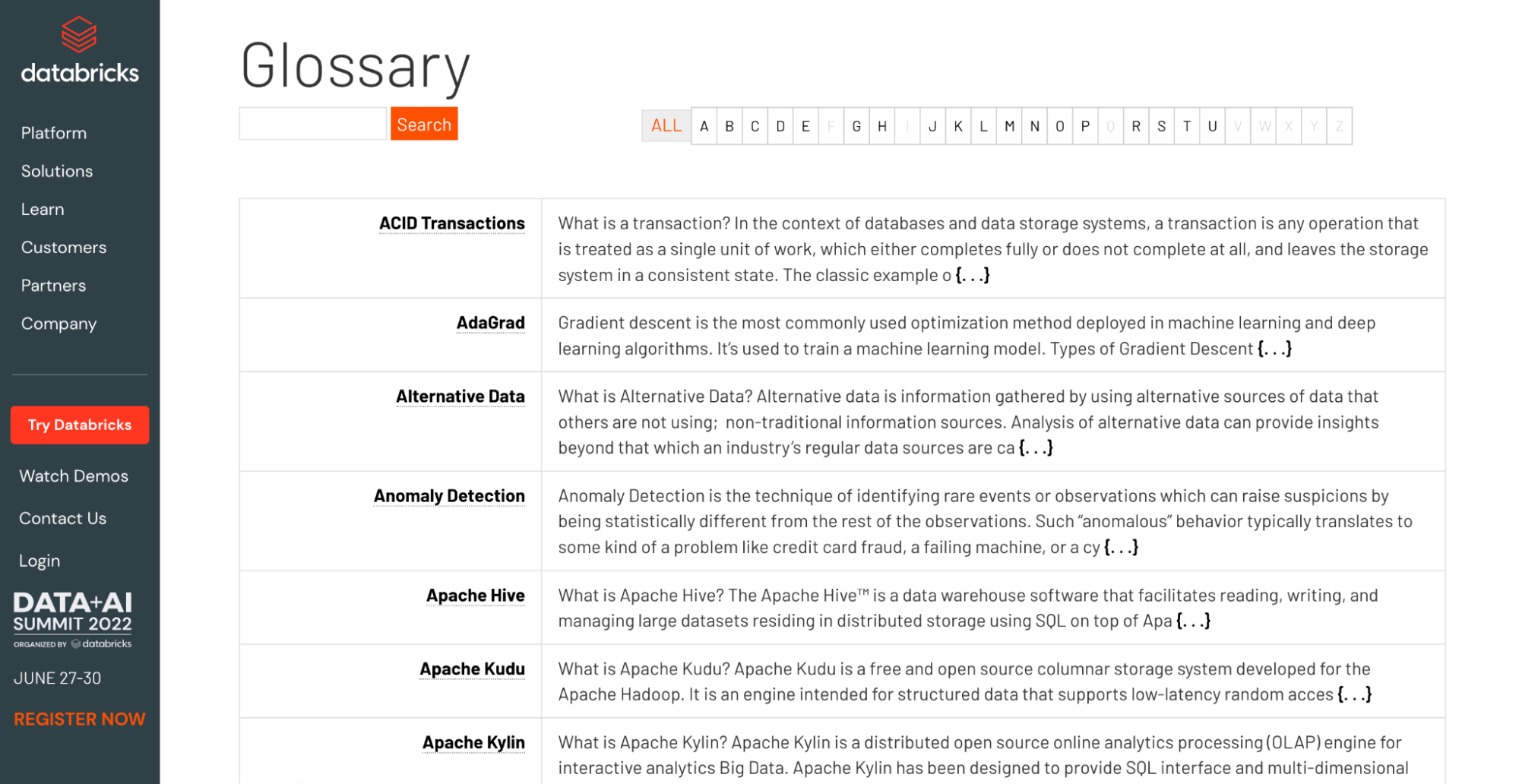
Let’s now examine how an individual glossary page is structured.
For this case study, we’ll be using the page explaining “Bayesian Neural Network” as an example.
1. Header and Intro
The page starts with a “What Are Bayesian Neural Networks?” header and an introductory paragraph that immediately explains the term in the header.
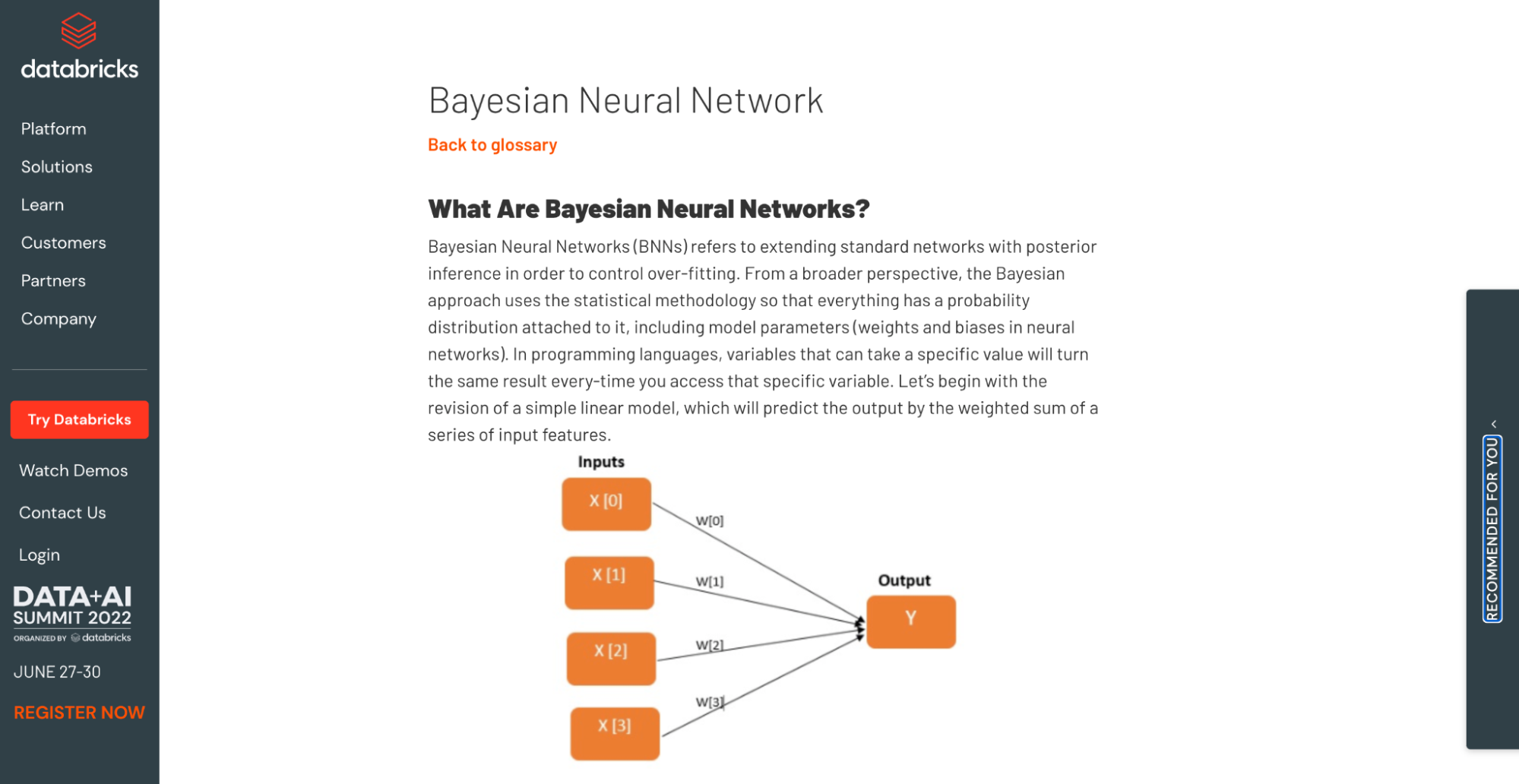
Since people are visiting this page to find out more about the meaning of Bayesian Neural Networks (BNN), there was no need for the Databricks team to come up with a long-winded intro that beats around the bush. Instead, the direct approach to defining the term instantly satisfies the reader’s curiosity and matches their informational search intent.
2. Imagery
Immediately after the introductory paragraph is an image that illustrates the Bayesian model.

Adding an image helps readers with short attention spans to focus on the page. And since they’re also more memorable, it helps readers retain information better.
You don’t necessarily have to use a picture as Databricks did here. Instead, you could use a video to capture attention, make your message more memorable, and even increase the time readers spend on your web pages.
3. Secondary Headers and Paragraphs
H2s and paragraphs that further explain the glossary follow the intro and image. In the case of the Bayesian Neural Network term, the H2s are:
- What Are Some of the Main Advantages of BNNs?
- Why Should You Use Bayesian Neural Networks?
Both of which add more context to the meaning of BNNs.
The paragraphs under these headers include semantically related keywords that assist in making the glossary page rank higher on SERPs.
Concerning content length, this particular page about BNNs is around 436 words. The other pages also fall within the 400-600 word range — enough to define a term and provide additional valuable information about it.
4. Additional Resources
This section of the glossary page provides readers with additional resources they can use to become more familiar with a term. But that’s not all.
The “Additional Resources” section is also a vital real estate on this glossary page to link to other pages within the Databricks website.

Internal linking is vital as it signals to Google that a page is valuable. These links also allow the Googlebot to crawl a website and identify content that’s related.
5. CTA
Finally, the glossary page ends with a call to action asking readers to try Databricks for free.

Remember that most of the people landing on this page are looking for more information, not for something to buy. So having the button at the bottom — appearing only after people are done reading — makes Databricks seem considerate and not sales-y.
While it might look simple, a lot of work goes into creating these glossary pages to make them a valuable resource. But how can you tell if your glossary page is working? You’ll need to set and track specific goals.
Setting and Tracking Goals for Your Glossary Page
You simply cannot create a glossary page just because it’s working for Databricks. Instead, it’s crucial to understand the needs of your specific audience to determine whether a glossary page is what they need.
If that’s the case, here are some goals to set and metrics to track to ensure you achieve those goals.
1. Educate Your Audience(s)
Educating your audience should be one of the most important goals for your glossary pages. After all, people are coming there to get informed or educated.
You can check your performance for this goal by tracking metrics like:
- Page views
- Bounce rates
- Pages per session
- Time on page
- Unique visitors
All of which you can find in Google Analytics.
2. Increase Brand Awareness
Like most marketing materials, your glossary pages can also help you increase your brand awareness. By raising your brand awareness, you stay at the top of your customer’s minds, making it easier for them to turn to you when they want to make a purchase.
Some of the metrics to track for this goal are:
- Branded searches
- Links from external sources
- Social mentions
3. Generate Demands/Leads
Even though glossary pages are not of a commercial nature, you can still set the goal of using them to drive conversions. However, in this case, conversions mean offers like asking readers to join your email list or download an ebook.
The KPIs you can track for this goal include leads generated and the number of email subscribers.
4. Build Authority
Although this goal is relatively harder to measure than the rest, it’s a valid goal to pursue.
As you use your glossary page to build authority, your audience will trust you more. In time, your brand becomes the go-to/most reliable resource when people have a question concerning topics in your niche.
Becoming the go-to resource when people have questions can easily translate to them thinking of you first when they are ready to buy.
Wrapping Up
Databricks’ use of glossary pages to dominate the AI and Big Data Analytics market is a truly remarkable feat. It goes to show that not just players like Investopedia and Moz in popular industries like finance and SEO can win with glossary pages.
With the keyword glossary strategy, you too have the formula to build an SEO moat that can help you achieve fast, sustainable, and scalable growth. And don’t forget to set goals for your glossary pages and track KPIs to determine how well the pages are working.
Quick, do it now before the next drop!







